
Enchanting Wilderness of Saxon Switzerland National Park
Discover the breathtaking beauty of Saxon Switzerland National Park, a natural paradise in Germany known for its towering sandstone cliffs, lush forests, and stunning views.
Nestled in the heart of Germany, Saxon Switzerland National Park is a haven for nature lovers and adventure seekers alike. Spanning over 93 square kilometers, this park is renowned for its stunning sandstone formations, verdant forests, and meandering rivers. The Elbe River cuts through the park, creating a picturesque landscape that has inspired artists for centuries. The park offers a myriad of activities for visitors. Hiking trails, such as the famous Malerweg or Painter's Way, provide breathtaking views of the unique rock formations and lush valleys. For those who enjoy climbing, the park is home to over 1,000 climbing peaks, catering to both beginners and experienced climbers. Water enthusiasts can explore the Elbe River by canoe or kayak, adding a touch of adventure to their visit. Wildlife enthusiasts will be delighted by the park's diverse fauna. Keep an eye out for rare species such as the peregrine falcon and the elusive lynx. The park's flora is equally impressive, with ancient woodlands and vibrant wildflowers painting a stunning natural tapestry. Whether you are seeking tranquility or an adrenaline rush, Saxon Switzerland National Park offers an unforgettable experience in a serene, natural setting.
Local tips in Saxon Switzerland National Park
- Visit during spring or autumn for the best weather and fewer crowds.
- Wear sturdy hiking boots to navigate the rocky terrain comfortably.
- Bring a camera to capture the park's stunning landscapes and unique rock formations.
- Check local regulations if you plan to climb; some areas are protected.
- Consider staying in a nearby village for easy access to the park and a taste of local culture.
Enchanting Wilderness of Saxon Switzerland National Park
Nestled in the heart of Germany, Saxon Switzerland National Park is a haven for nature lovers and adventure seekers alike. Spanning over 93 square kilometers, this park is renowned for its stunning sandstone formations, verdant forests, and meandering rivers. The Elbe River cuts through the park, creating a picturesque landscape that has inspired artists for centuries. The park offers a myriad of activities for visitors. Hiking trails, such as the famous Malerweg or Painter's Way, provide breathtaking views of the unique rock formations and lush valleys. For those who enjoy climbing, the park is home to over 1,000 climbing peaks, catering to both beginners and experienced climbers. Water enthusiasts can explore the Elbe River by canoe or kayak, adding a touch of adventure to their visit. Wildlife enthusiasts will be delighted by the park's diverse fauna. Keep an eye out for rare species such as the peregrine falcon and the elusive lynx. The park's flora is equally impressive, with ancient woodlands and vibrant wildflowers painting a stunning natural tapestry. Whether you are seeking tranquility or an adrenaline rush, Saxon Switzerland National Park offers an unforgettable experience in a serene, natural setting.
When is the best time to go to Saxon Switzerland National Park?
Iconic landmarks you can’t miss
Pravčická Archway
Experience the breathtaking beauty of Pravčická Archway, Europe's largest sandstone arch, nestled in the stunning landscapes of Czechia's Bohemian Switzerland.

Felsentor 'Kuhstall'
Experience the breathtaking beauty of Felsentor 'Kuhstall', a stunning natural rock formation in Saxon Switzerland, perfect for hiking and stunning views.

Carolafelsen
Experience the breathtaking views and natural beauty of Carolafelsen, a must-visit scenic spot in Bad Schandau, Saxon Switzerland.

Saxon Switzerland Mountains
Experience the stunning Saxon Switzerland Mountains, a breathtaking escape into nature with spectacular views, hiking trails, and unique rock formations.

Waldhusche Hinterhermsdorf
Explore Waldhusche Hinterhermsdorf, a stunning national park in Sebnitz, Germany, where nature's beauty and adventure await every traveler.

Wide Crevice
Discover the breathtaking hiking trails and stunning views at Wide Crevice in Bad Schandau, a must-visit destination for nature lovers and outdoor enthusiasts.

Stairway to Heaven
Experience breathtaking views and exhilarating trails at the Stairway to Heaven in Bad Schandau, a hiking paradise in Saxon Switzerland.

Heilige Stiege
Experience the breathtaking beauty of Heilige Stiege, a hiking paradise in Bad Schandau, where nature’s wonders meet adventure.

Kleinstein Cave
Discover the breathtaking views and hiking adventures at Kleinstein Cave in Kirnitzschtal, a hidden gem for nature lovers and explorers.

Sächsische Schweiz vorderer Teil National Park
Explore the stunning landscapes of Sächsische Schweiz National Park, a natural treasure in Germany with breathtaking views, rich biodiversity, and endless outdoor adventures.

Herrman's Corner
Explore the breathtaking Herrman's Corner in Saxon Switzerland, a hiking paradise with stunning views and diverse trails for all adventurers.

Hickel Cave
Explore the stunning Hickel Cave in Kirnitzschtal - a must-visit scenic spot for nature lovers and adventure seekers in Germany.

Bloßstock
Explore the breathtaking beauty of Bloßstock, a must-visit tourist attraction in Bad Schandau, perfect for outdoor enthusiasts and nature lovers.
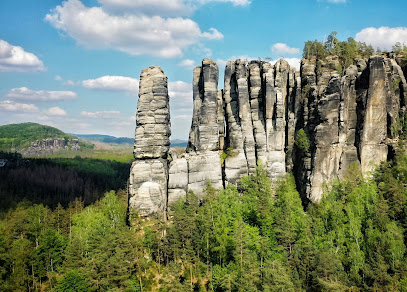
Rübezahl's Steps
Discover the stunning landscapes and hiking opportunities at Rübezahl's Steps in Saxon Switzerland National Park, a perfect escape for nature lovers.

Sächsische Schweiz National Park
Experience the breathtaking beauty of Sächsische Schweiz National Park, where stunning landscapes and outdoor adventures await in the heart of Germany.
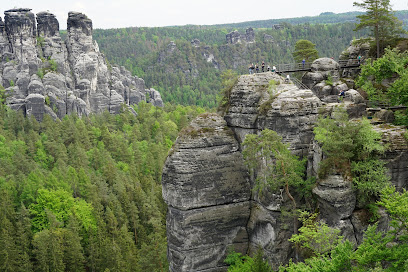
Unmissable attractions to see
Protected Landscape Area Elbe Sandstone Mountains
Explore the breathtaking natural beauty and rich biodiversity of the Elbe Sandstone Mountains, a protected landscape area in Czechia.

Dolský mlýn
Explore Dolský mlýn, a historical gem in the Czech Republic, surrounded by breathtaking landscapes and rich cultural heritage.

Belvedere Viewpoint
Discover breathtaking views at Belvedere Viewpoint in Děčín-Hřensko, a perfect blend of nature and stunning landscapes.

Kleine Sächsische Schweiz
Explore the breathtaking beauty of Kleine Sächsische Schweiz, a hidden gem in Germany featuring stunning landscapes, charming parks, and rich cultural heritage.

Schrammsteinaussicht
Experience stunning panoramic views and hiking adventures at Schrammsteinaussicht, a breathtaking gem in Saxon Switzerland National Park.

Basteiaussicht
Experience the breathtaking views and scenic hiking trails at Basteiaussicht in Saxon Switzerland—an outdoor paradise for all nature lovers.

Museum, Pension & Restaurant - Eisenbahnwelten im Kurort Rathen
Explore the fascinating world of railways and savor authentic German cuisine at Eisenbahnwelten in Kurort Rathen.
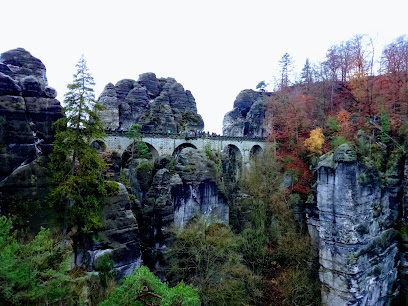
Falkenstein Castle
Explore the majestic ruins of Falkenstein Castle in Czechia, a breathtaking historical landmark surrounded by stunning hiking trails and scenic views.

Šaunštejn / Schauenstein Castle
Explore the stunning Šaunštejn Castle, a historical gem in Czechia offering breathtaking views and rich cultural heritage.
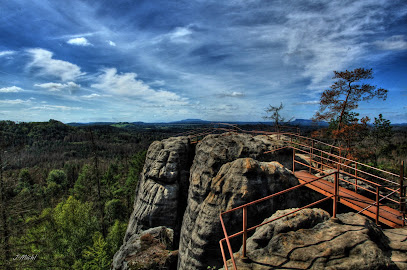
Pfaffenstein Nature Reserve
Explore the stunning landscapes and diverse wildlife at Pfaffenstein Nature Reserve, a must-visit destination for nature lovers in Königstein, Germany.

Carolafelsen
Explore Carolafelsen in Bad Schandau, a scenic spot offering breathtaking views of the Elbe River and stunning landscapes in Saxon Switzerland National Park.

Urzeit Park
Experience the thrill of dinosaurs at Urzeit Park, an exhilarating amusement park in Sebnitz, Germany, perfect for families and adventure-seekers.

Emmabank
Discover the natural beauty of Emmabank, a scenic spot in Bad Schandau, where breathtaking views and tranquility await every visitor.

Lichterhoehle
Discover the enchanting Lichterhöhle in Gohrisch, a stunning cave adorned with unique geological features and serene natural beauty.

Malá Pravčická brána
Explore the breathtaking Malá Pravčická Brána, a stunning natural arch in the heart of Bohemian Switzerland, perfect for nature lovers and adventure seekers.

Essential places to dine
Hotel Elbresidenz an der Therme Bad Schandau
Experience unparalleled luxury and relaxation at Hotel Elbresidenz an der Therme Bad Schandau amidst Saxon Switzerland's stunning landscapes.

Panoramarestaurant Bastei
Experience breathtaking views and traditional German cuisine at Panoramarestaurant Bastei in Saxon Switzerland National Park.

Gasthaus Heiterer Blick
Experience authentic German cuisine at Gasthaus Heiterer Blick in Sebnitz, where traditional flavors meet stunning views.
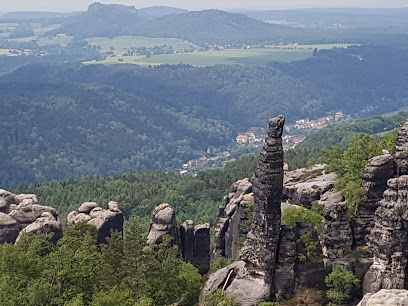
Gasthof & Landhotel Sennerhütte, Sächsischen Schweiz
Discover authentic German cuisine and breathtaking landscapes at Gasthof & Landhotel Sennerhütte in Sächsische Schweiz.
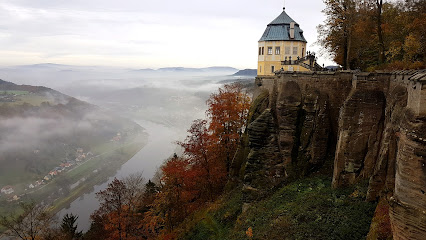
Gambrinus
Experience traditional German cuisine at Gambrinus in Bad Schandau – where every meal tells a story.

Gaststätte und Pension Schrammsteinbaude
Experience authentic local cuisine and cozy accommodations at Gaststätte und Pension Schrammsteinbaude in Bad Schandau's stunning landscapes.

Pension und Gaststätte Polenztal
Experience comfort and culinary delights at Pension und Gaststätte Polenztal in Hohnstein, where nature meets hospitality.

Parkhotel Bad Schandau
Experience luxury and nature at Parkhotel Bad Schandau - your perfect retreat in Saxon Switzerland.

Neumann Mill
Experience traditional German cuisine at Neumann Mill's inviting restaurant and beer garden in scenic Saxon Switzerland.

Zur Schlossbastei
Discover the essence of German cuisine at Zur Schlossbastei, where tradition meets modern taste in Bad Schandau's charming atmosphere.

Wachbergbaude Saupsdorf
Discover Wachbergbaude Saupsdorf - your perfect mountain retreat for delicious local cuisine and breathtaking nature views.

Hotel & Restaurant Forsthaus - Pura Hotels GmbH
Discover tranquility and culinary excellence at Hotel & Restaurant Forsthaus in beautiful Kirnitzschtal Valley.

Liethen Mill
Experience authentic German cuisine and cozy accommodations at Liethen Mill in Gohrisch – where tradition meets tranquility.

Schmilk'sche Mühle mit Bäckerei & Biergarten
Experience authentic German flavors at Schmilk'sche Mühle – A historic bakery and beer garden nestled in scenic Schmilka.

The Falcon Inn
Discover comfort and authentic Czech cuisine at The Falcon Inn in Hřensko - your gateway to nature's beauty.

Markets, malls and hidden boutiques
Lidl
Discover quality groceries and organic options at Lidl in Bad Schandau, your one-stop shop for all your travel needs.

RATAGS Kunsthandwerk GmbH & Co. KG
Discover unique handcrafted gifts, clothing, and toys at RATAGS Kunsthandwerk in Stolpen - a vibrant shopping experience awaits!

Dragon Shopping Center
Explore the Dragon Shopping Center for an unforgettable shopping experience in Dolní Poustevna, filled with diverse stores and delightful eateries.

nobilis Tilia
Explore the unique blend of natural cosmetics and wellness at nobilis Tilia in Krásná Lípa, a must-visit for beauty lovers and relaxation seekers.
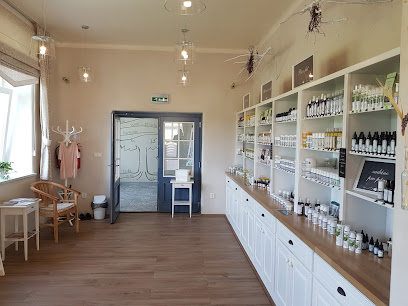
National Park Center Saxon Switzerland
Explore the breathtaking Saxon Switzerland National Park at the National Park Center, where nature's beauty and rich biodiversity come alive.

Saxon Switzerland Mountains
Explore Saxon Switzerland Mountains: a breathtaking blend of stunning rock formations, hiking trails, and rich cultural history in Germany's natural paradise.

Besucherbergwerk „Marie Louise Stolln“
Experience the rich mining history and artisan culture at Marie Louise Stolln, a unique tourist attraction in Bad Gottleuba-Berggießhübel.

Information Center & Souvenirs
Discover Jetřichovice's Information Center & Souvenirs, your gateway to local treasures and hiking adventures in Czechia.

Velta Free Shop
Explore Hřensko's Velta Free Shop for a unique shopping experience filled with quality goods and local craftsmanship in a picturesque setting.

star Tankstelle
Discover convenience and quality at star Tankstelle in Sebnitz, where fueling up meets delicious treats and essential services.

VELTA Free Shop
Explore the best of Dolní Poustevna at VELTA Free Shop, your go-to destination for local groceries and unique Czech products.

Villa Thusnelda & Café Richter
Experience the charm of Schmilka at Villa Thusnelda & Café Richter, where delicious local cuisine meets cozy accommodations in a breathtaking setting.

Tillig Modellbahnen GmbH
Explore the enchanting world of model railroads at Tillig Modellbahnen GmbH in Sebnitz – a paradise for train lovers and curious tourists.

IT Shop
Discover top-notch electronics and exceptional service at IT Shop, the premier electronics store in Šluknov, Czechia.

Café La Vita Sebnitz
Discover the sweet escape of Café La Vita Sebnitz, where artisanal ice creams and delightful desserts await in a charming setting.

Essential bars & hidden hideouts
Eiscafé „Vivaldi“
Discover the authentic taste of Italy at Eiscafé Vivaldi, where scrumptious ice creams and traditional dishes await in Bad Schandau.

Gaststätte und Pension Schrammsteinbaude
Discover the serene charm and culinary delights of Gaststätte und Pension Schrammsteinbaude in Bad Schandau, the perfect retreat for nature lovers.

Landgasthaus Ziegelscheune
Experience authentic local cuisine and stunning views at Landgasthaus Ziegelscheune, a perfect dining destination in Bad Schandau.

Biergarten Schloßschänke Pirna-Sonnenstein
Discover the authentic flavors and warm hospitality at Biergarten Schloßschänke Pirna-Sonnenstein, a charming beer garden in scenic Pirna.

Neumann Mill
Experience the perfect blend of traditional German cuisine and breathtaking nature at Neumann Mill in Kirnitzschtal.
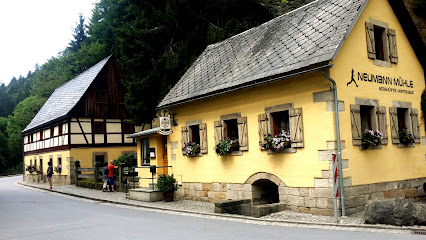
Schmilk'sche Mühle mit Bäckerei & Biergarten
Experience the taste of tradition at Schmilk'sche Mühle, a charming bakery and beer garden nestled in the heart of Schmilka, Germany.

Zur Eiche
Experience authentic local cuisine and warm hospitality at Zur Eiche, a charming restaurant and bed & breakfast in the heart of Bad Schandau.

Bio-Restaurant StrandGut
Discover the essence of organic dining at Bio-Restaurant StrandGut in Schmilka, where every dish celebrates local flavors and sustainability in a breathtaking setting.

Ottendorfer Hütte
Discover the charm of Ottendorfer Hütte, a delightful restaurant and beer garden in Sebnitz, offering local cuisine and a beautiful outdoor ambiance.

Gastwirtschaft Altes Zeughaus
Experience the essence of traditional German cuisine at Gastwirtschaft Altes Zeughaus, nestled in the beautiful Kirnitzschtal valley.

Gasthof zur Hoffnung Gasthof / Gaststätte, Gasthof, Pension
Experience authentic German hospitality at Gasthof zur Hoffnung in Sebnitz, nestled near the stunning landscapes of Saxon Switzerland.
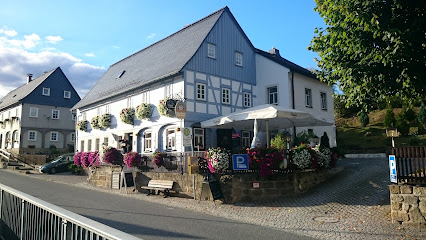
Flößerstube
Discover Flößerstube in Bad Schandau, where traditional German cuisine meets stunning natural beauty, offering a delightful dining experience.
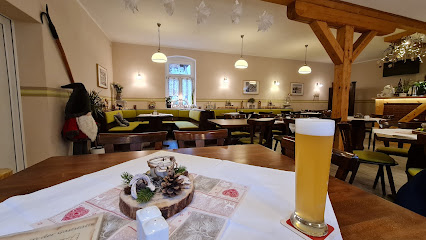
Radelbar
Discover Radelbar, a charming beer garden in Dresden offering local brews, delicious snacks, and a relaxing riverside atmosphere.

The Cowshed - Mountain Inn
Discover The Cowshed - Mountain Inn, a delightful restaurant in Bad Schandau offering local delicacies amidst stunning mountain views.

Tasca las Flores
Discover the vibrant flavors of Spain at Tasca las Flores, Königstein's premier tapas bar serving authentic dishes in a charming atmosphere.

Local Phrases about Saxon Switzerland National Park
-
- HelloHallo
[hah-loh] - GoodbyeAuf Wiedersehen
[owf vee-der-zay-en] - YesJa
[yah] - NoNein
[nine] - Please/You're welcomeBitte
[bi-teh] - Thank youDanke
[dahn-kuh] - Excuse me/SorryEntschuldigung
[ent-shool-dee-goong] - How are you?Wie geht es dir?
[vee gayt es deer] - Fine. And you?Gut. Und dir?
[goot oont deer] - Do you speak English?Sprechen Sie Englisch?
[shpre-khen zee eng-leesh] - I don't understandIch verstehe nicht
[ikh fair-shtay-uh nikht]
- HelloHallo
-
- I'd like to see the menu, pleaseIch würde gerne die Speisekarte sehen, bitte
[ikh vur-deh gehr-neh dee shpy-zuh-kahr-teh zay-en, bi-teh] - I don't eat meatIch esse kein Fleisch
[ikh es-seh kine flysh] - Cheers!Prost!
[prohst] - I would like to pay, pleaseIch möchte bitte bezahlen
[ikh muhkh-teh bi-teh bezah-len]
- I'd like to see the menu, pleaseIch würde gerne die Speisekarte sehen, bitte
-
- Help!Hilfe!
[hil-feh] - Go away!Geh weg!
[geh veg] - Call the Police!Rufen Sie die Polizei!
[roo-fen zee dee poh-lee-tsy] - Call a doctor!Rufen Sie einen Arzt!
[roo-fen zee i-nen artsht] - I'm lostIch habe mich verirrt
[ikh hah-buh mikh fair-irt] - I'm illIch bin krank
[ikh been krunk]
- Help!Hilfe!
-
- I'd like to buy...Ich möchte kaufen...
[ikh muhkh-teh kow-fen] - I'm just lookingIch schaue nur
[ikh show-eh noor] - How much is it?Wie viel kostet es?
[vee feel koss-tet es] - That's too expensiveDas ist zu teuer
[dahs ist tsoo toy-er] - Can you lower the price?Können Sie den Preis senken?
[ker-nen zee den preys senk-en]
- I'd like to buy...Ich möchte kaufen...
-
- What time is it?Wie spät ist es?
[vee shpet ist es] - It's one o'clockEs ist ein Uhr
[es ist iyn oor] - Half past (10)Halb elf
[halb elf] - MorningMorgen
[mohr-gen] - AfternoonNachmittag
[nahkh-mit-tahk] - EveningAbend
[ah-bend] - YesterdayGestern
[geh-stern] - TodayHeute
[hoi-teh] - TomorrowMorgen
[mohr-gen] - 1Eins
[ines] - 2Zwei
[tsvai] - 3Drei
[dry] - 4Vier
[feer] - 5Fünf
[foonf] - 6Sechs
[zeks] - 7Sieben
[zee-ben] - 8Acht
[akht] - 9Neun
[noyn] - 10Zehn
[tsayn]
- What time is it?Wie spät ist es?
-
- Where's a/the...?Wo ist ein/der...?
[vo ist ine/der] - What's the address?Was ist die Adresse?
[vas ist dee ah-dre-suh] - Can you show me (on the map)?Können Sie mir das zeigen (auf der Karte)?
[ker-nen zee meer das tsay-gen (owf der kar-teh)] - When's the next (bus)?Wann kommt der nächste (Bus)?
[van kohmt der nekhs-teh (boos)] - A ticket (to ....)Eine Fahrkarte (nach ....)
[i-ne fahr-kahr-teh (nakh)]
- Where's a/the...?Wo ist ein/der...?
History of Saxon Switzerland National Park
-
The unique landscape of Saxon Switzerland National Park is the result of millions of years of geological activity. The area is characterized by its stunning sandstone formations, which were formed about 100 million years ago during the Cretaceous period. Over time, erosion and weathering sculpted the distinctive rock towers, cliffs, and deep gorges that we see today.
-
Evidence of early human settlements in Saxon Switzerland dates back to the Stone Age. Archaeological findings, including tools and remnants of primitive dwellings, indicate that prehistoric humans inhabited the region, utilizing its natural resources for survival. The rugged terrain provided both shelter and strategic advantage.
-
During the Middle Ages, the area became strategically important due to its natural defensive features. Several castles and fortresses were built, including the famous Königstein Fortress. This massive stronghold, perched atop a 240-meter-high table mountain, played a crucial role in regional defense and served as a refuge during times of conflict.
-
In the 18th and 19th centuries, Saxon Switzerland became a popular destination for artists, writers, and poets. The breathtaking landscapes inspired numerous works of art, contributing to the Romantic movement. Famous painters like Caspar David Friedrich captured the ethereal beauty of the region in their masterpieces, making it a symbol of romantic naturalism.
-
Recognizing the area's unique natural beauty and ecological significance, Saxon Switzerland National Park was officially established in 1990. The park covers an area of 93.5 square kilometers and aims to preserve the pristine landscape and diverse ecosystems. It is a haven for outdoor enthusiasts, offering activities like hiking, climbing, and wildlife observation.
-
The region surrounding Saxon Switzerland National Park boasts a rich cultural heritage. Traditional Saxon villages, with their half-timbered houses and historic churches, dot the landscape. Local customs, festivals, and culinary specialties, such as Saxon potato soup and Quarkkäulchen, offer visitors a glimpse into the area’s vibrant cultural traditions.
Saxon Switzerland National Park Essentials
-
Saxon Switzerland National Park is located in the eastern part of Germany, near the border with the Czech Republic. The nearest major city is Dresden, approximately 30 kilometers away. To reach the park, you can fly into Dresden Airport and then take a train from Dresden Hauptbahnhof to Bad Schandau, one of the main gateways to the park. The train journey takes about 45 minutes. Alternatively, you can drive from Dresden, which takes around 40 minutes via the A17 and B172 roads.
-
Once in the park, transportation options include hiking, cycling, and using the local ferry services along the Elbe River. The S-Bahn (S1 line) connects Dresden with key towns such as Pirna and Bad Schandau. From Bad Schandau, various bus services can take you deeper into the park. Biking is also a popular and eco-friendly way to explore the park. For those preferring guided tours, several companies offer excursions by bus or boat.
-
The official currency in Germany is the Euro (EUR). Credit and debit cards are widely accepted in hotels, restaurants, and shops in and around the national park. However, it is advisable to carry some cash, especially when visiting smaller villages and rural areas. ATMs are available in towns like Bad Schandau and Pirna for cash withdrawals.
-
Saxon Switzerland National Park is generally a safe destination for tourists. However, it is always wise to take standard precautions such as keeping an eye on your belongings and avoiding isolated areas at night. Pickpocketing can occur in crowded places, so remain vigilant. There are no specific high-crime areas targeting tourists within the park.
-
In case of an emergency, dial 112 for immediate assistance. This number can be used to reach the police, fire brigade, or medical services. The town of Bad Schandau has a medical center and pharmacies where you can get over-the-counter medications. It is advisable to have travel insurance that covers medical emergencies.
-
Fashion: Do wear comfortable hiking boots and weather-appropriate outdoor clothing. Avoid wearing high heels or formal dress. Religion: Do respect local religious sites and practices. Some areas may have churches or chapels where modest attire is appreciated. Public Transport: Do validate your ticket before boarding trains and buses. Don’t eat or drink on public transport. Greetings: Do greet people with a friendly 'Hallo' or 'Guten Tag.' A firm handshake is standard. Eating & Drinking: Do try local specialties like Saxon potato soup and quarkkeulchen. Don’t forget to say 'Prost!' when clinking glasses.
-
To experience Saxon Switzerland National Park like a local, consider hiking the Malerweg Trail, which offers stunning views and less crowded paths. Visit the Kirnitzschtal Tramway, a historic tram that takes you through picturesque valleys. Engage with locals in the towns and villages; they are often willing to share tips and stories about the region. Don’t miss a boat trip on the Elbe River for a unique perspective of the sandstone cliffs.
Trending Landmarks in Saxon Switzerland National Park
-
Pravčická Archway
-
Felsentor 'Kuhstall'
-
Carolafelsen
-
Saxon Switzerland Mountains
-
Waldhusche Hinterhermsdorf
-
Wide Crevice
-
Stairway to Heaven
-
Heilige Stiege
-
Kleinstein Cave
-
Sächsische Schweiz vorderer Teil National Park
-
Herrman's Corner
-
Hickel Cave
-
Bloßstock
-
Rübezahl's Steps
-
Sächsische Schweiz National Park
Nearby Cities to Saxon Switzerland National Park
-
Things To Do in Prague
-
Things To Do in Karlovy Vary
-
Things To Do in Kutná Hora
-
Things To Do in Hradec Králové
-
Things To Do in Leipzig
-
Things To Do in Plzeň
-
Things To Do in Potsdam
-
Things To Do in Berlin
-
Things To Do in Wroclaw
-
Things To Do in České Budějovice
-
Things To Do in Erfurt
-
Things To Do in Český Krumlov
-
Things To Do in Poznan
-
Things To Do in Brno
-
Things To Do in Olomouc











